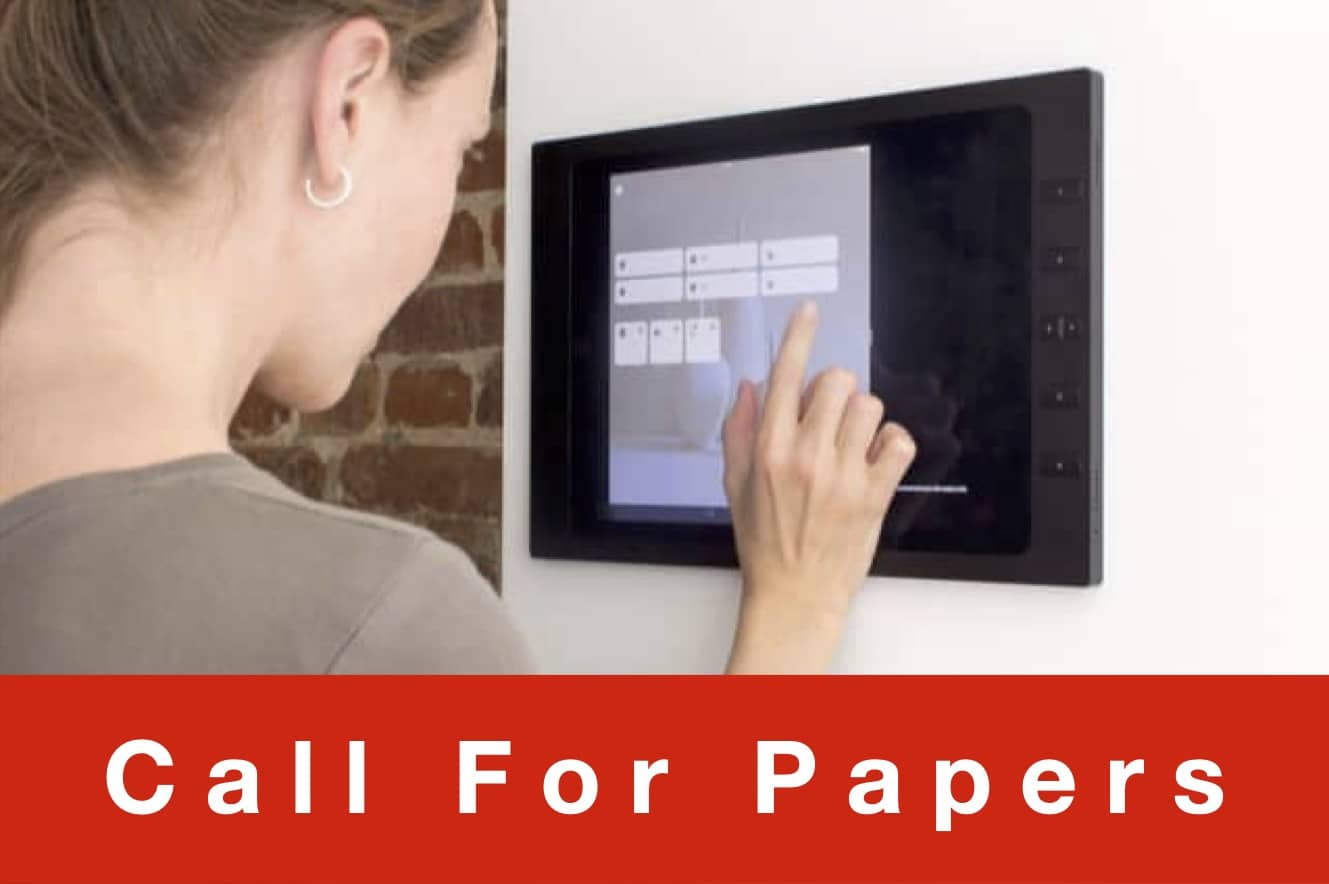
www.buildingsandcities.org/calls-for-papers/energy-gender-homes.html
Energy, Emerging Technologies and Gender in Homes

Guest editors: Kirsten Gram-Hanssen & Yolande Strengers
Abstract submissions closed on: 07 SEPTEMBER 2021
How are visions, relationships and practices with emerging technologies and energy interacting with gender relations and dynamics in homes?
From aspirations for leisure-enhancing electronic and digital gadgets through to self-cleaning buildings, imaginaries (visions) of technology in the home reflect long-held gendered associations (Berg 1994; Cowan 1989). This special issue investigates how emerging technologies are informed by gender and generate gendered effects in ways that support or undermine energy policies and initiatives. The issue will explore the relationship between gender, emerging technologies and energy from many perspectives, to help realise more gender-inclusive technologies, buildings, policies, programs and outcomes, and to ensure that gender insights can assist in making energy policy more effective by building on everyday life understandings.
Aims
The special issue aims to improve understanding regarding the gendered diversity and effects in the development of, and experiences with, emerging technologies of relevance to energy in homes. The issue will provide critical advice for key stakeholders such as policy makers, regulators, planners, technologists, designers and housing developers for future gender-inclusive energy technologies and approaches which work in everyday life.
For this special issue, issues of concern include household interactions and relationships with energy or smart technologies, as well as experiences with a broad range of emerging technologies - such as consumer electronics, robotics and automation - and how these shape and are shaped by gender in ways that affect energy outcomes. We are interested in contributions that address gendered visions, experiences and outcomes with a wide variety of emerging technologies including:
- Smart home devices: broadly encompassing smart appliances, thermostats, digital voice assistants, consumer electronics, home robotics, Internet of Things (IoT), and other automated home technologies
- Energy technologies: e.g. solar PV, batteries, electric vehicles, microgrids, and virtual power plants
- Other technologies having potential energy implications e.g. augmented /virtual reality, artificial intelligence, cryptocurrencies, autonomous vehicles, pay-as-you-go energy purchasing via mobile phone (common in the Global South).
The special issue also explores the impact of gender on realising policy, regulatory and building efficiency aspirations. Set against broader political agendas and imaginaries for Big Tech, decarbonisation and energy reform, emerging technologies are often considered key enablers of future visions for low-carbon futures. Yet questions about whose futures are being enabled and imagined, or who is doing the work to enable them, are left unanswered (Aagaard 2021; Jasanoff 2015; Sovacool 2019). Insufficient attention to gender and socio-cultural dynamics may undermine the green and just transition of the energy system.
Background
The smart or digital home has long been a tantalising prospect, with enticing visions regularly on display in science fiction books, films and display homes (Dourish & Bell 2011). In recent and specific iterations of the energy (smart) home - featuring home automation and load control, electric vehicles, solar and battery integration, real-time feedback, demand response and/or improved efficiency - questions of gender are inescapable, as everyday practices and technologies are gendered and thus inform energy outcomes. There has been considerable attention paid to the social and household dynamics involved with smart technologies and the impacts this has on energy outcomes (Darby 2018; Gram-Hanssen & Darby 2018; Hansen et al. 2019; Hargreaves & Wilson 2017, 2018; Nicholls & Strengers 2019; Ransan-Cooper et al. 2020). However, less attention has been given to gender in such analyses, making it an important issue in need of concerted focus (Johnson 2020; Furszyfer et al. 2021; Mechlenborg & Gram-Hanssen 2020; Pink 2004; Strengers 2013; Tjørring et al. 2018). Questions remain about whose interests are represented in the visions for technologies; who does the work involved in setting up, maintaining, using or responding to technologies in the home (Kennedy et al. 2015; Rode & Poole 2018; Strengers & Nicholls 2018); how smart technologies are gendered by design or ergonomics (Perez 2019; Strengers & Kennedy 2020); how the non-human agency of emerging technologies interacts with gender in both the design and use phase (Gram-Hanssen, 2019; Morley 2019; Kuijer 2019); and what new 'cyborgs' are emerging that transcend traditional understandings of gender and feminism (Haraway 2013).
Suggested Topics
Emerging technologies in the home
- What are the gendered experiences of the occupants of energy smart homes? How do emerging technologies shape and impact on gender relations within the home, including gendered dynamics of different households (heterosexual or same sex couples) and/or of 'digital housekeeping' (Tolmie et al. 2013)?
- How is gender shaping the learning and use of emerging technology? What kinds of gendered knowledge and experiences are prioritised in the technologies for energy smart homes?
- What impact will gendered relations with emerging energy technologies have for a decarbonised transition?
- How do the gendered experiences of occupants in sustainable homes and other types of homes compare to smart homes?
- How do emerging technologies physically embody gender, how do different types of non-human agency interact with gender? What implications does this have for social relations in and beyond the home?
- How should we understand gender in relationship to emerging technologies in the home? Do we need to revise our assumptions, concepts or theories of gender or feminism?
Industry visions and policy progress
- How are visions/imaginaries of the energy smart home, IoT devices and other emerging technologies gendered by different types of actors (Big Tech; energy companies; policy makers etc.) and what impact does this have on their development?
- How do visions/imaginaries of emerging technologies reflect, reinforce or depart from historically gendered associations between energy, technology and/or the home?
- How do science fiction, popular culture or other imaginaries contribute to gendered technology and energy imaginaries in the home?
- Who stands to gain or lose from current visions of smart homes and energy technologies? Are there positive examples for changing and challenging gendered energy and technology visions and outcomes?
- How can policies and industry stakeholders respond to the gendered challenges and make their technologies, policies and programs for the home more gender inclusive and equitable?
- What gender insights on emerging technologies and energy are important to include in policy for a sustainable transition?
Neighbourhoods and communities
- How does gender play a role in neighbourhood and community energy projects?
- Do neighborhood projects differ from household-based energy technologies in their gendered visions or effects?
Intersectional approaches
- How do the gendered visions and/or experiences of energy and technology intersect with issues of race, culture, disability, socio-economic status or other forms of diversity and potential disadvantage?
- How does technology shape gendered relations and roles in the home, across different countries, geographical contexts and socio-political situations?
Briefing Note for Contributors
You are invited to submit an abstract for a journal paper in this special issue of Buildings & Cities. In the first instance, please send a 500 word (maximum) abstract defining the scope, methods and results to Richard Lorch richard@rlorch.net by TUESDAY 7 SEPTEMBER 2021. The initial abstract submission must include:
- The author's and all co-authors' names, affiliations, and contact details
- The question(s) and topics in this Call for Papers that the abstract and intended paper addresses
- The abstract (300-500 words maximum) which should include a description of methods and key findings.
Abstracts will be reviewed by the editors to ensure a varied, yet integrated selection of papers around the topic of the special issue.
Authors of accepted abstracts will be invited to submit a full paper which then undergoes a double-blind peer review process. The journal publishes the several different types of papers: research, synthesis, policy analysis, methods, & replication, see: https://bit.ly/3iQOaIF
SYMPOSIUM: Authors of accepted abstracts will receive feedback from the editors and be asked to prepare a short (5-10 minute) presentation of their paper at an online symposium (held over several weeks and across multiple time zones) for the special issue authors, to be held in November 2021. Papers will be thematically grouped and each lead author will be asked to comment on another paper's abstract and presentation. Authors will be invited to attend all sessions of the symposium but are only required to attend those featuring their paper and/or the paper they are asked to comment on. After the symposium which will allow for further feedback and discussion around the special issue, full papers will be submitted by 11 March 2022.
Timeline
Deadline for abstract submission 7 September 2021
Symposium to discuss and develop paper ideas 3, 4, 8, 9 November 2021
Full papers
due 11
March 2022 (NB: authors can submit sooner if they wish)
Referees' comments 15 May 2022
Final version due 30 June 2022
Publication August 2022 (NB: papers are published as soon as they are accepted)
Buildings & Cities journal
Buildings & Cities is an international, open access, not-for-profit, double-blind peer-reviewed research journal. Its focus is the interactions between buildings, neighbourhoods and cities by understanding their supporting social, economic and environmental systems. More information including its Aims & Scope, Key Principles and Editorial Board can be found online: www.buildingsandcities.org.
Buildings & Cities is an open access journal and has an article processing charge of £1200 (plus VAT if applicable). If you do not have institutional support, please contact the editor to discuss. We endeavour to assist those without funding to publish in our journal.
Editorial team
R. Lorch (Buildings & Cities), Guest editors: K. Gram-Hanssen (Aalborg U) & Y. Strengers (Monash U). Assistants: L. K. Aagaard (Aalborg U), K. Dahlgren (Monash U)
Questions?
If you have a question, please contact:
Richard Lorch richard@rlorch.net or Kirsten Gram-Hanssen kgh@build.aau.dk
References
Aagaard, L. K. (2021). The meaning of convenience in smart home imaginaries: tech industry insights. Buildings and Cities. https://doi.org/10.5334/bc.93
Berg, A. J. (1994). A gendered socio-technical construction: the smart house. In C. Cockburn & R. Furst Dilic (Eds.), Bringing technology home: gender and technology in changing Europe (pp. 165-180). Open University Press.
Cowan, R. S. (1989). More Work for Mother: the Ironies of Household Technology from the Open Hearth to the Microwave. London: Free Association Books.
Darby, S. J. (2018). Smart technology in the home: time for more clarity. Building Research & Information, 46(1), 140-147. https://doi.org/10.1080/09613218.2017.1301707
Dourish, P., & Bell, G. (2011). Divining a Digital Future. MIT Press.
Furszyfer Del Rio, D. D., Sovacool, B. K., & Martiskainen, M. (2021). Controllable, frightening, or fun? Exploring the gendered dynamics of smart home technology preferences in the United Kingdom. Energy Research & Social Science, 77, 102105. https://doi.org/10.1016/j.erss.2021.102105
Gram-Hanssen, K., & Darby, S. J. (2018). "Home is where the smart is"? Evaluating smart home research and approaches against the concept of home. Energy Research & Social Science, 37 (Supplement C), 94-101. https://doi.org/10.1016/j.erss.2017.09.037
Hansen, A. R., Madsen, L. V., Knudsen, H. N., & Gram-Hanssen, K. (2019). Gender, age, and educational differences in the importance of homely comfort in Denmark. Energy Research & Social Science, 54, 157-165. https://doi.org/10.1016/j.erss.2019.04.004
Haraway, D. (2013). Simians, cyborgs, and women: The reinvention of nature. Routledge.
Hargreaves, T., & Wilson, C. (2017). Smart Homes and Their Users. Springer.
Hargreaves, T., Wilson, C., & Hauxwell-Baldwin, R. (2018). Learning to live in a smart home. Building Research & Information, 46(1), 127-139. Https://doi.org/10.1080/09613218.2017.1286882
Jasanoff, S. (2015). Future Imperfect: Science, Technology, and the Imaginations of Modernity. In S. Jasanoff & S.-H. Kim (Eds.), Dreamscapes of modernity: Sociotechnical imaginaries and the fabrication of power (pp. 1-33). University of Chicago Press.
Johnson, C. (2020). Is demand side response a woman's work? Domestic labour and electricity shifting in low income homes in the United Kingdom. Energy Research & Social Science, 68, 101558. https://doi.org/10.1016/j.erss.2020.101558
Kennedy, J., Nansen, B., Arnold, M., Wilken, R., & Gibbs, M. (2015). Digital housekeepers and domestic expertise in the networked home. Convergence, 21(4), 408-422.
Nicholls, L., & Strengers, Y. (2019). Robotic vacuum cleaners save energy? Raising cleanliness conventions and energy demand in Australian households with smart home technologies. Energy Research & Social Science, 50, 73-81. https://doi.org/10.1016/j.erss.2018.11.019
Mechlenborg, M., & Gram-Hanssen, K. (2020). Gendered homes in theories of practice: A framework for research in residential energy consumption. Energy Research and Social Science, 67 https://doi.org/10.1016/j.erss.2020.101538
Perez, C. C. (2019). Invisible women: Exposing data bias in a world designed for men. Random House.
Pink, S. (2004). Home Truths: Gender, domestic objects and everyday life. Oxford: Berg.
Ransan-Cooper, H., Lovell, H., Watson, P., Harwood, A., & Hann, V. (2020). Frustration, confusion and excitement: Mixed emotional responses to new household solar-battery systems in Australia. Energy Research & Social Science, 70, 101656. https://doi.org/10.1016/j.erss.2020.101656
Rode, J. A., & Poole, E. S. (2018). Putting the gender back in digital housekeeping. Paper presented at the Proceedings of the 4th Conference on Gender & IT, Heilbronn, Germany. https://doi-org.ezproxy.lib.monash.edu.au/10.1145/3196839.3196845
Sovacool, B. K. (2019). Visions of Energy Futures: Imagining and Innovating Low-Carbon Transitions. Routledge.
Strengers, Y. (2013). Smart Energy Technologies in Everyday Life: Smart Utopia? Basingstoke: Palgrave Macmillan.
Strengers, Y., & Kennedy, J. (2020). The Smart Wife: Why Siri, Alexa and other Smart Home Devices Need a Feminist Reboot. Cambridge: MIT Press.
Strengers, Y., & Nicholls, L. (2018). Aesthetic pleasures and gendered tech-work in the 21st-century smart home. Media Internat'l Australia, 166(1), 70-80.
Tjørring, L., Jensen, C., Hansen, L., & Andersen, L. (2018). Increasing the Flexibility of Electricity Consumption in Private Households: Does Gender Matter? Energy Policy, 118, 9-18. https://doi.org/10.1016/j.enpol.2018.03.006
Tolmie, P., Crabtree, A., Rodden, T., Greenhalgh, C., & Benford, S. (2007). Making the Home Network at Home: Digital Housekeeping. Paper presented at the ECSCW'07, Limerick, Ireland.
Latest Peer-Reviewed Journal Content
Youth engagement in urban living labs: tools, methods and pedagogies
N Charalambous, C Panayi, C Mady, T Augustinčić & D Berc
Co-creating urban transformation: a stakeholder analysis for Germany’s heat transition
P Heger, C Bieber, M Hendawy & A Shooshtari
Placemaking living lab: creating resilient social and spatial infrastructures
M Dodd, N Madabhushi & R Lees
Church pipe organs: historical tuning records as indoor environmental evidence
B Bingley, A Knight & Y Xing
A framework for 1.5°C-aligned GHG budgets in architecture
G Betti, I Spaar, D Bachmann, A Jerosch-Herold, E Kühner, R Yang, K Avhad & S Sinning
Net zero retrofit of the building stock [editorial]
D Godoy-Shimizu & P Steadman
Co-learning in living labs: nurturing civic agency and resilience
A Belfield
The importance of multi-roles and code-switching in living labs
H Noller & A Tarik
Researchers’ shifting roles in living labs for knowledge co-production
C-C Dobre & G Faldi
Increasing civic resilience in urban living labs: city authorities’ roles
E Alatalo, M Laine & M Kyrönviita
Co-curation as civic practice in community engagement
Z Li, M Sunikka-Blank, R Purohit & F Samuel
Preserving buildings: emission reductions from circular economy strategies in Austria
N Alaux, V Kulmer, J Vogel & A Passer
Urban living labs: relationality between institutions and local circularity
P Palo, M Adelfio, J Lundin & E Brandão
Living labs: epistemic modelling, temporariness and land value
J Clossick, T Khonsari & U Steven
Co-creating interventions to prevent mosquito-borne disease transmission in hospitals
O Sloan Wood, E Lupenza, D M Agnello, J B Knudsen, M Msellem, K L Schiøler & F Saleh
Circularity at the neighbourhood scale: co-creative living lab lessons
J Honsa, A Versele, T Van de Kerckhove & C Piccardo
Positive energy districts and energy communities: how living labs create value
E Malakhatka, O Shafqat, A Sandoff & L Thuvander
Built environment governance and professionalism: the end of laissez-faire (again)
S Foxell
Co-creating justice in housing energy transitions through energy living labs
D Ricci, C Leiwakabessy, S van Wieringen, P de Koning & T Konstantinou
HVAC characterisation of existing Canadian buildings for decarbonisation retrofit identification
J Adebisi & J J McArthur
Simulation and the building performance gap [editorial]
M Donn
Developing criteria for effective building-sector commitments in nationally determined contributions
P Graham, K McFarlane & M Taheri
Join Our Community

The most important part of any journal is our people – readers, authors, reviewers, editorial board members and editors. You are cordially invited to join our community by joining our mailing list. We send out occasional emails about the journal – calls for papers, special issues, events and more.
We will not share your email with third parties. Read more



Latest Commentaries
COP30 Report
Matti Kuittinen (Aalto University) reflects on his experience of attending the 2025 UN Conference of the Parties in Belém, Brazil. The roadmaps and commitments failed to deliver the objectives of the 2025 Paris Agreement. However, 2 countries - Japan and Senegal - announced they are creating roadmaps to decarbonise their buildings. An international group of government ministers put housing on the agenda - specifying the need for reduced carbon and energy use along with affordability, quality and climate resilience.
Building-Related Research: New Context, New Challenges
Raymond J. Cole (University of British Columbia) reflects on the key challenges raised in the 34 commissioned essays for Buildings & Cities 5th anniversary. Not only are key research issues identified, but the consequences of changing contexts for conducting research and tailoring its influence on society are highlighted as key areas of action.